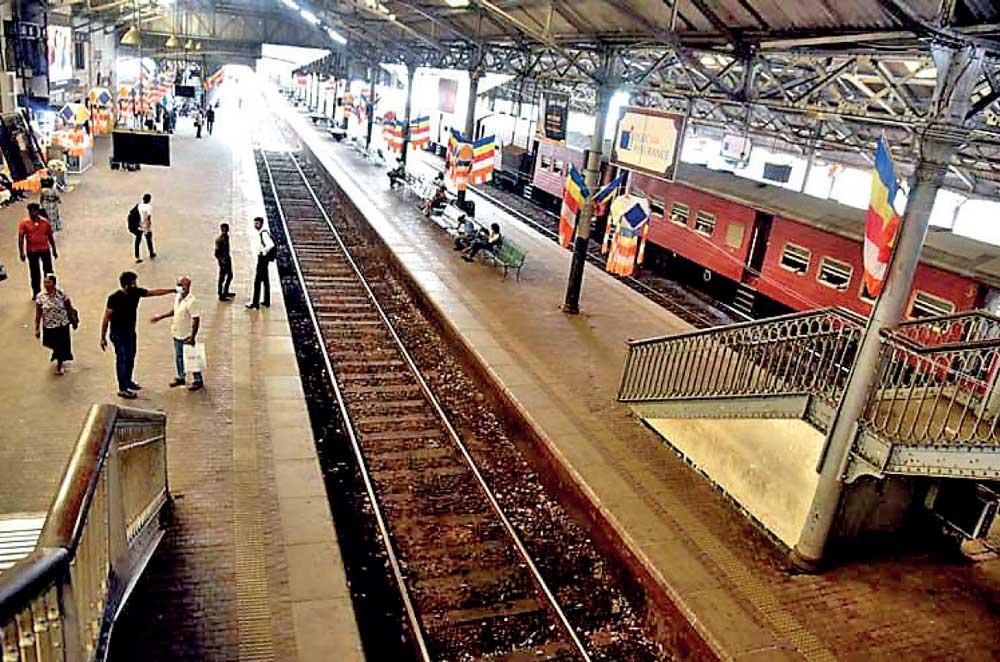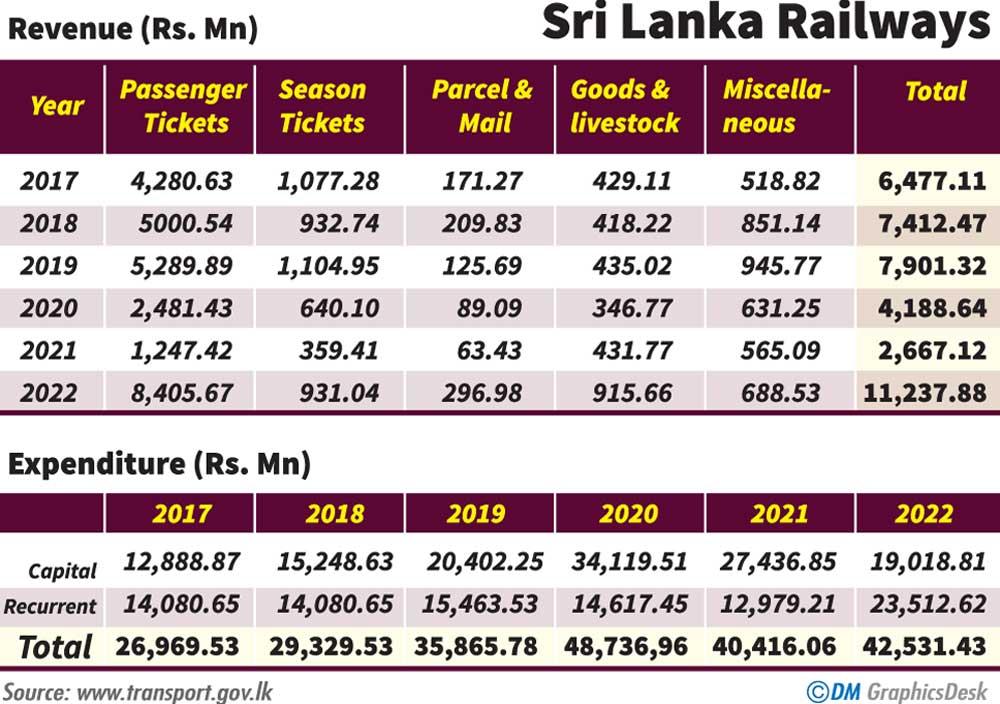Reply To:
Name - Reply Comment

CGR operates more as a paradise for a few thousand employees, while the poor taxpayers bear the burden

 In 1807, Revd. James Cordiner, Chaplain to Colombo Garrisons observed, “Strictly speaking there are no roads in the island...” However, he failed to propose any solutions and was unaware that waterways and cart tracks already existed. The Hamilton Canal, named after Gavin Hamilton, the Government Agent of Revenue and Commerce, had been completed three years earlier, in 1804.
In 1807, Revd. James Cordiner, Chaplain to Colombo Garrisons observed, “Strictly speaking there are no roads in the island...” However, he failed to propose any solutions and was unaware that waterways and cart tracks already existed. The Hamilton Canal, named after Gavin Hamilton, the Government Agent of Revenue and Commerce, had been completed three years earlier, in 1804.
‘The Ceylon Herald’, one of the oldest English newspapers in Colonial Ceylon, reported 38 years later on its September 16, 1845 issue, “British enterprises are changing the face of the earth; but great projectors are often turn mad—it is a maxim in political economy that heavy goods can be conveyed by canal at less cost than by any other means…”
Hamilton Canal – The 126 km long ‘Dutch Canal’, connecting Puttalam to Colombo and passing through Negombo, was initially constructed by the Portuguese in the 17th century. The Dutch, in the 18th century, built additional structures and dams, and the British further improved it in the first decade of the 19th century for transporting cinnamon in barges (paaru/ flat bottomed padda boats) to the nearest port. During the 15th century, under the rule of King Vira Parakramabahu VIII, the Negombo Lagoon served as the main seaport for trading cinnamon and other commodities. The King began constructing the canal to facilitate access and transport. As Brohier noted, these canals formed a “continuous line of waterways between ports and the remote sections of territory under the Dutch.” After renovation, the Hamilton Canal could still be effectively used today for transporting goods and passengers, serving as an additional alternative to railways.
I reminisced about the fascinating episodes filled with nostalgia that my late father shared. He began his trading at the Nattandiya Bazaar in the District of Chilaw, located on the banks of the Hamilton Canal. In 1916, as a young entrepreneur and in the absence of automobiles, he owned a fleet of three ‘Paaru’ for transporting the export crop ‘copra’ (dried, white flesh of the coconut from which coconut oil is extracted) to Colombo Port and carrying provisions for retailers on the return journey of a week-long trip. They sailed for six nights, taking turns rowing while reciting folk poems (paaru kavi). I still remember one of his favourite four lines:
“Suuriya udawana thuru pini bevilla,
Paaruwa padina thuru jalaye selavilla,
Maaruwa bala balaa hithayata kerakilla,
Kaariya kerena thuru kageth revatilla.”
“Dew lasts only until sunrise,
The water shakes as the barge moves.
The mind spins, seeing change arise;
They deceive all until their goal is achieved.” [Not aimed at the politicians of the time]
A Modern Canal Network?
In August 2018, the Yahapalana government approved a project to maintain an inland water transport service on various waterways. The Sri Lanka Land Reclamation and Development Corporation has initiated a passenger boat service from Colombo Fort to Union Place via Beira Lake to alleviate traffic congestion in the city. With the launch of this service, it will be possible to travel from Colombo Fort to Union Place in less than 15 minutes. The boat service has been identified as an ideal solution to ease traffic congestion.
The approved routes included services from Battaramulla to Wellawatte, Mattakkuliya to Hanwella across the Kelani River, and Fort to Union Place via Beira Lake, among others. The government completed a pre-feasibility study on inland water transport, planned by Minister of Megapolis and Western Development, Patali Champika Ranawaka, to secure support and investment from the Dutch government. This project should be revamped to mark the beginning of a new era of water-based transport in modern Sri Lanka. By utilising the country’s numerous rivers, man-made tanks, and canals, this initiative would add a novel dimension to the transport network, significantly easing congestion on roads and railways.
History of Transport Strikes
Carters Strike, 1906: John Kotelawala [Snr], Father of Sir John, who had expanded into the transportation industry that relied on bullock carts in the 19th century, decided to lead the carters’ struggle when over 5,000 carters planned to launch an island-wide agitation campaign through a strike. The strike began on August 11, 1906, a decade before Automotives were introduced. Business was crippled and all work in the city came to a standstill. On the morning of August 13, they left the cattle sheds, realising they could not balance the carts well unless allowed to sit on the shaft or pole, a practice that the new Municipal bylaw banned.
The shipping of cargo, including crops and plumbago, was severely disrupted causing chaos in the plantations and mining industry. When the government decided to employ private company carts and gharries to transport urgent goods under police escort to the wharf, the carters defiantly sat on the shafts and poles in the presence of policemen, willfully flouting the law as instructed by Kotelawala, the ex-policeman turned businessman. Carters won their reasonable demand.– History of Ceylon Police: Vol II-A C Dep
Railway Strike, 1923: The first General Strike occurred in February 1923, led by A. E. Gunasinghe, ‘Father of the Labour Movement’ when the Government Railway struck [later joined by numerous other Unions].
Tram Car Strike,1929: On January 23, 1929, Gunasinghe launched a strike by tramcar workers. Whittal Bousteads, the owners of the tramcars, used the police to harass the strikers, leading to a clash. As the strike spread to other institutions and demonstrations followed, the Maradana Police Station was set on fire.
Bus Strike, 1947: Philip Gunawardena, the staunch Marxist, lost his Parliamentary seat when he was convicted by Court for leading employees of the South Western Transport Company of the bus tycoon Sir Cyril de Zoysa, in the General Strike in 1947 led by the Lanka Sama Samaja Party (LSSP). In the by-election that followed, Gunawardena’s wife, Kusuma won the Avissawella seat.
Wildcat Strikes Leave Commuters Stranded
Station masters left tens of thousands of passengers to either brave the dangerously overcrowded trains that kept running or be stranded at the station. Railway employees abruptly ‘down tools’ without any warning, taking turns in their actions. Highly paid engine drivers go on strike to protest issues such as pay, working conditions and promotions. After a few days, as they return to work, their colleagues in the electronic controllers department stage a walkout. Following this, station masters also stay at home, causing untold misery for commuters. Unlike in other countries, wildcat strikes here are supported by trade unions affiliated with political parties run by leaders with ulterior motives.
Losing billions annually, the Ceylon Government Railway (CGR), often labelled a ‘national asset’, has unfortunately become a national curse. It operates more as a paradise for a few thousand employees, while the poor taxpayers bear the burden. Instead of serving the broader interests of the country, its inefficiencies and financial losses significantly strain the national economy.
Privatisation should be prioritised as a solution. By transferring management to the private sector, there is potential to improve operational efficiency, reduce financial losses, and better serve the public, turning this struggling entity into a truly valuable asset.
The author can be reached at [email protected]